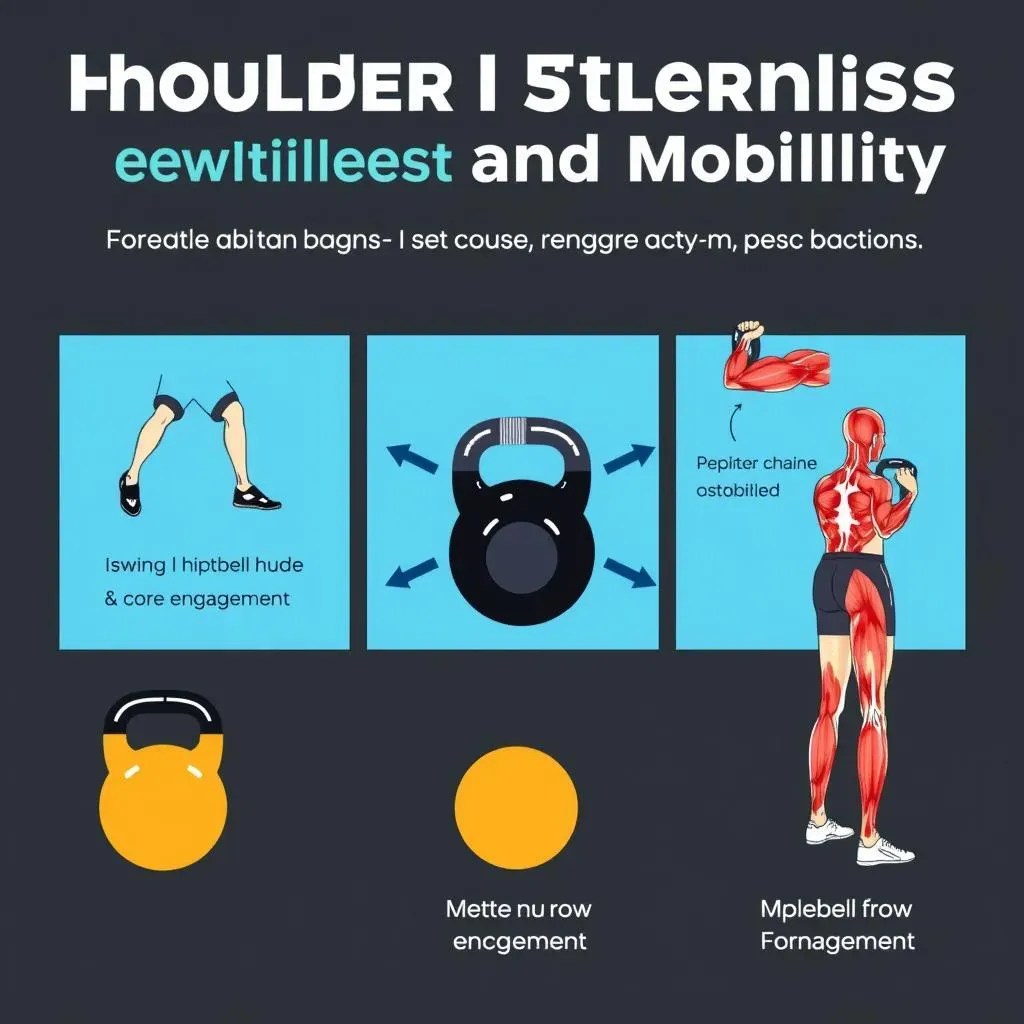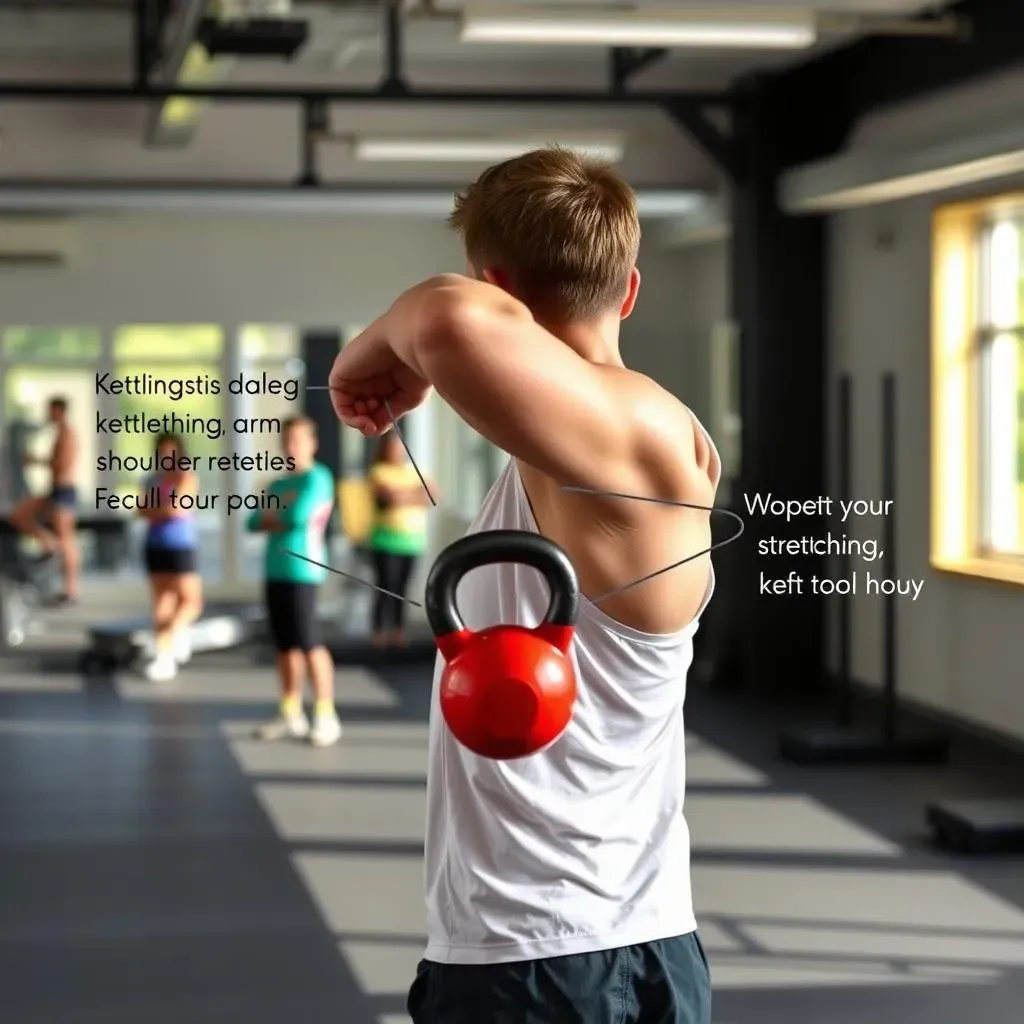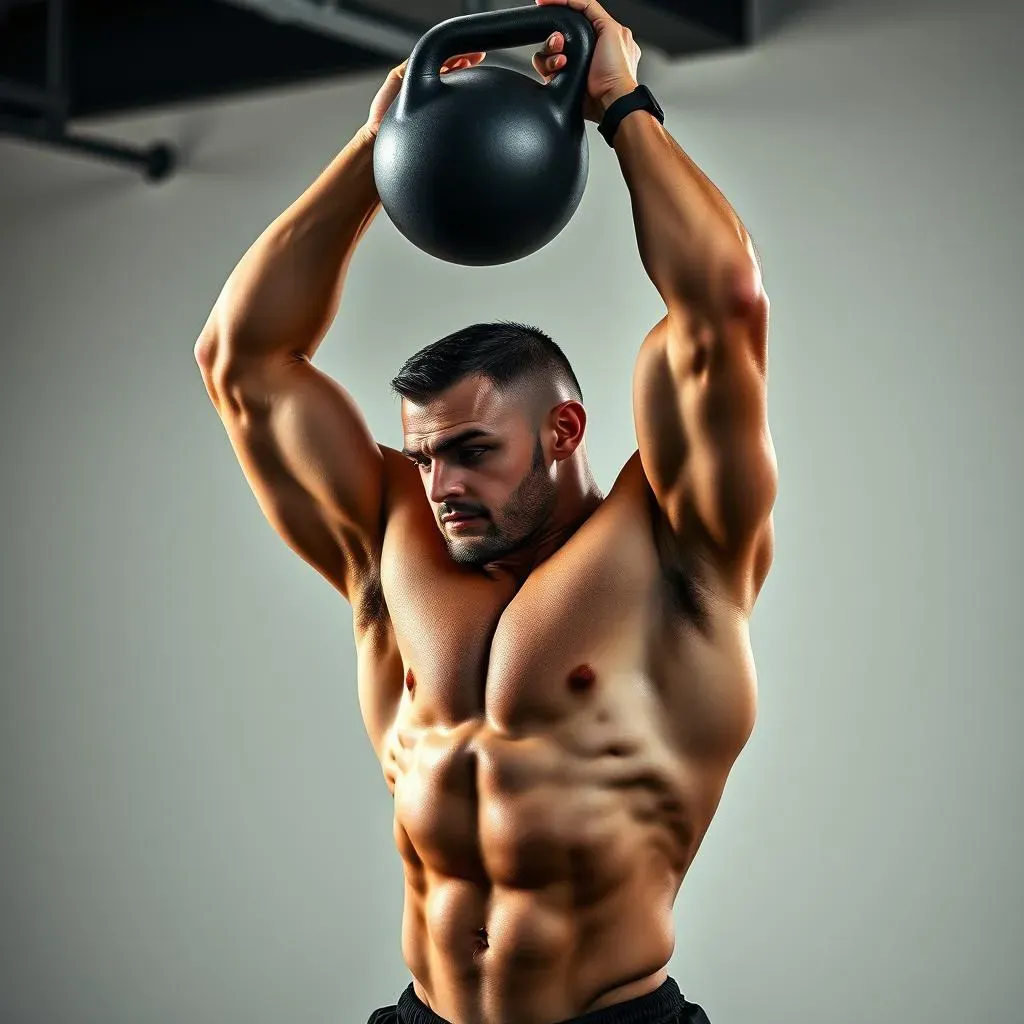Table of Contents
Ready to build boulder shoulders with a single piece of equipment? Forget endless hours at the gym. A **kettlebell workout for shoulders** is your ticket to strength, mobility, and a physique that commands attention. This isn't just about aesthetics; it's about unlocking your body's potential for functional movement and injury prevention. We'll explore why kettlebells are superior for shoulder training, diving into key exercises like swings, presses, and rows that target every angle of your deltoids and rotator cuff. Learn how to structure your workouts for maximum gains, mastering the sets, reps, and progression strategies that separate the winners from the wannabes. But it's not all about pushing hard; we'll also cover crucial safety tips to avoid shoulder pain and keep you training consistently. Finally, for those ready to take it up a notch, we'll explore advanced techniques that will challenge even the most seasoned kettlebell enthusiasts. So, ditch the dumbbells and prepare to swing your way to stronger, healthier shoulders!
Why Kettlebells Are Your New Best Friend for Shoulder Workouts

Why Kettlebells Are Your New Best Friend for Shoulder Workouts
Let's face it, the gym can be a drag. Endless rows of machines, the grunts, the waiting... But what if I told you that you could ditch most of that and still sculpt incredible shoulders? That's where kettlebells come in. They're not just a trendy fitness fad; they're a powerhouse for shoulder development, offering a unique blend of strength, stability, and mobility benefits that traditional dumbbells and machines simply can't match. Think of it this way: dumbbells isolate muscles, while kettlebells force your entire body to work as a unit, especially your core and shoulder stabilizers, leading to more functional strength and a reduced risk of injury. It’s like upgrading from a bicycle to an all-terrain vehicle for your workout.
Essential Kettlebell Exercises for Shoulder Strength and Mobility

Essential Kettlebell Exercises for Shoulder Strength and Mobility
Kettlebell Swings: The Foundation
Let's start with the king (or queen!) of kettlebell exercises: the swing. It's not just a leg and glute exercise; when done correctly, it's fantastic for shoulder stability and power. The swing teaches you to connect your lower body drive to your upper body, creating a powerful chain reaction that strengthens your entire posterior chain, including those often-neglected shoulder stabilizers. Think of it as a dynamic plank – your core is engaged, your lats are firing to control the kettlebell, and your shoulders are working to keep everything aligned.
Imagine you're snapping a towel – that's the kind of explosive hip hinge we're aiming for. The kettlebell should float up to chest height, not because you're lifting it with your arms, but because your hips are propelling it. This forces your shoulders to stabilize against the momentum, building incredible resilience. Start with lighter weights and focus on mastering the hip hinge and keeping your back straight. Trust me, your shoulders will thank you later.
Kettlebell Presses: Building Overhead Strength
Now, let's get into some overhead work. The kettlebell press, whether it's a strict press, push press, or jerk, is a phenomenal way to build shoulder strength and stability. What's great about kettlebells is the offset load, which forces your shoulder stabilizers to work overtime to keep the weight balanced. This is unlike a dumbbell press, where the weight is evenly distributed. That offset load is where the magic happens, demanding more from your rotator cuff and smaller stabilizing muscles.
The key here is control. Don't just heave the kettlebell overhead. Focus on a slow, controlled ascent and descent, feeling your shoulder muscles working throughout the entire range of motion. Start with the kettlebell in the racked position (resting on your forearm), engage your core, and press the weight straight up, locking out your elbow at the top. Lower it back down slowly, maintaining control. If you find yourself arching your back excessively, you're probably using too much weight.
Exercise | Sets | Reps | Rest |
|---|---|---|---|
Kettlebell Swings | 3 | 15-20 | 60 seconds |
Kettlebell Strict Press | 3 | 8-12 | 90 seconds |
Kettlebell Rows | 3 | 10-15 per side | 60 seconds |
Kettlebell Rows: Strengthening the Backside
Don't forget about your posterior chain! Strong shoulders need a strong back to support them. Kettlebell rows are an excellent way to target your lats, rhomboids, and rear deltoids, all of which play a crucial role in shoulder health and stability. The kettlebell row allows for a greater range of motion than a dumbbell row, which can help improve shoulder mobility and flexibility.
There are a few variations you can try. The standard kettlebell row involves hinging at the hips, keeping your back straight, and rowing the kettlebell towards your chest. You can also try a renegade row, which is performed in a plank position, adding an extra core challenge. No matter which variation you choose, focus on squeezing your shoulder blades together at the top of the movement and controlling the weight on the way down. This will help build a strong, balanced back that supports healthy shoulders.
Crafting Your Kettlebell Workout for Shoulders: Sets, Reps, and Progression

Crafting Your Kettlebell Workout for Shoulders: Sets, Reps, and Progression
Finding Your Starting Point
so you've got the exercises down. Now, how do you actually put together a **kettlebell workout for shoulders** that's effective and, more importantly, sustainable? It all starts with understanding your current fitness level. Are you a complete beginner, or do you have some experience with kettlebells or weight training? Be honest with yourself. There's no shame in starting small. In fact, it's the smartest way to avoid injury and build a solid foundation. Think of it like learning a new language; you wouldn't jump straight into reading Shakespeare, would you? You'd start with the basics.
So, if you're new to kettlebells, start with lighter weights and focus on mastering the form. This might mean using a kettlebell that feels almost too light at first, but trust me, your shoulders will thank you. Focus on nailing the movement patterns, feeling the right muscles engage, and maintaining control throughout the entire exercise. Once you can perform the exercises with good form for the prescribed sets and reps, then you can start thinking about increasing the weight or adding more challenging variations.
Structuring Your Workout: Sets, Reps, and Rest
Alright, let's get down to the nitty-gritty of sets, reps, and rest periods. There's no one-size-fits-all answer here; it depends on your goals. Are you looking to build strength, endurance, or a combination of both? For building strength, you'll generally want to stick to lower reps (6-8) with heavier weights and longer rest periods (2-3 minutes). For endurance, you'll want to increase the reps (12-15) with lighter weights and shorter rest periods (30-60 seconds). And for a balanced approach, aim for moderate reps (8-12) with moderate weights and moderate rest periods (60-90 seconds).
As for sets, 3 sets per exercise is a good starting point. You can always increase the number of sets as you get stronger. Remember to listen to your body and adjust the sets, reps, and rest periods as needed. Don't be afraid to experiment to find what works best for you. The most important thing is to be consistent and to gradually increase the challenge over time. This is known as progressive overload, and it's the key to long-term progress. For example, if you're able to easily perform 3 sets of 12 reps with a certain weight, it's time to increase the weight or try a more challenging variation of the exercise.
Goal | Reps | Sets | Rest |
|---|---|---|---|
Strength | 6-8 | 3-5 | 2-3 minutes |
Endurance | 12-15 | 3-5 | 30-60 seconds |
Hypertrophy | 8-12 | 3-4 | 60-90 seconds |
Avoiding Shoulder Pain: Kettlebell Workout Safety Tips

Avoiding Shoulder Pain: Kettlebell Workout Safety Tips
Warm-Up Like a Pro
Alright, let's talk about the elephant in the room: shoulder pain. It's a common complaint among kettlebell enthusiasts, but it's often preventable with the right approach. The first step? A proper warm-up. Don't just jump straight into heavy swings. Your shoulders need to be prepped and ready for action. Think of it like starting a car on a cold morning – you wouldn't rev the engine right away, would you? You'd let it warm up gradually.
Your warm-up should include dynamic stretches that mimic the movements you'll be performing in your workout. Arm circles, shoulder rotations, and torso twists are all great options. You can also incorporate light kettlebell movements, like halos and arm bars, to get your joints lubricated and your muscles firing. The goal is to increase blood flow to your shoulders, improve mobility, and activate the muscles that support your shoulder joint. A good warm-up should leave you feeling loose, limber, and ready to tackle your workout.
- Arm Circles (forward and backward)
- Shoulder Rotations
- Torso Twists
- Kettlebell Halos
- Kettlebell Arm Bars
Listen to Your Body (Seriously!)
This might sound cliché, but it's crucial: listen to your body. Your body is constantly giving you feedback, and it's your job to pay attention. If you're feeling sharp pain in your shoulder during a kettlebell exercise, stop immediately. Don't try to push through it. Pain is a signal that something is wrong, and ignoring it can lead to serious injury. It's better to err on the side of caution and take a break than to risk sidelining yourself for weeks or months.
Also, don't be afraid to modify exercises or reduce the weight if needed. There's no shame in using a lighter kettlebell or performing a less challenging variation of an exercise. The key is to focus on maintaining good form and avoiding pain. And if you're consistently experiencing shoulder pain, even with proper form and warm-up, it's a good idea to consult with a physical therapist or other qualified healthcare professional. They can help you identify the underlying cause of your pain and develop a plan to address it.
Beyond the Basics: Advanced Kettlebell Shoulder Workout Techniques

Beyond the Basics: Advanced Kettlebell Shoulder Workout Techniques
Unilateral Training: The Key to Unlocking Imbalances
Ready to take your **kettlebell workout for shoulders** to the next level? It's time to embrace unilateral training. What does that mean? Simply put, it means working one side of your body at a time. Think single-arm presses, rows, and carries. Why is this so effective? Because it forces your core and shoulder stabilizers to work overtime to maintain balance and control. This not only builds strength but also helps to identify and correct any imbalances you might have. Most of us have a dominant side, and unilateral training can help to even things out, leading to improved posture, reduced risk of injury, and greater overall strength.
Start by incorporating single-arm variations of the exercises we've already discussed. The single-arm kettlebell press is a great place to start. Focus on maintaining a stable base and preventing your torso from rotating. You can also try single-arm kettlebell rows, which will challenge your core even further. And for an extra challenge, try carrying a kettlebell in one hand while walking. This is known as a farmer's carry, and it's an incredible full-body exercise that will build serious shoulder strength and stability. Remember to start with lighter weights and gradually increase the load as you get stronger.
Mastering the Turkish Get-Up: The Ultimate Shoulder Challenge
If you're looking for the ultimate kettlebell exercise for shoulder strength and stability, look no further than the Turkish Get-Up (TGU). This is a complex, full-body movement that requires incredible coordination, balance, and control. It involves transitioning from lying on the ground to standing upright, all while holding a kettlebell overhead. The TGU challenges your shoulders in every possible plane of motion, building incredible strength and stability. It's not just a shoulder exercise, though; it also works your core, hips, and legs. Think of it as a moving plank that builds incredible resilience and functional strength.
The TGU is a challenging exercise, so it's important to break it down into its component parts and master each step before attempting the full movement. Start by practicing the individual transitions, such as rolling to your elbow, posting to your hand, and sweeping your leg through. Once you're comfortable with each step, you can start linking them together. Be patient and persistent, and don't be afraid to ask for help from a qualified kettlebell instructor. The TGU is a rewarding exercise that will challenge you both physically and mentally. Once you've mastered it, you'll feel like you can conquer anything.
Exercise | Focus | Benefits |
|---|---|---|
Single-Arm Press | Shoulder Strength & Stability | Corrects imbalances, improves core stability |
Turkish Get-Up | Full-Body Coordination & Strength | Challenges shoulders in all planes of motion, builds core strength |
Farmer's Carry | Grip & Shoulder Endurance | Improves posture, builds overall strength |
Combining Movements: Creating Flow and Intensity
Once you've mastered the individual exercises, it's time to start combining them into flows. This involves linking multiple exercises together seamlessly, creating a dynamic and challenging workout. Flows are a great way to increase the intensity of your **kettlebell workout for shoulders** and improve your cardiovascular fitness. They also challenge your coordination and mental focus, as you need to remember the sequence of movements and transition smoothly between them.
One example of a flow is the "Clean and Press to Reverse Lunge." This involves cleaning the kettlebell to the racked position, pressing it overhead, and then stepping back into a reverse lunge. You can repeat this sequence for a set number of reps, or you can alternate sides with each rep. Another example is the "Swing to High Pull to Snatch." This involves performing a kettlebell swing, transitioning into a high pull, and then finishing with a snatch. Flows can be as simple or as complex as you like, so feel free to experiment and create your own variations. The key is to focus on maintaining good form throughout the entire sequence and to challenge yourself without sacrificing safety.
Conclusion: Swing Your Way to Shoulder Success
Incorporating a kettlebell workout into your routine can revolutionize your shoulder strength and mobility. From understanding the benefits of kettlebells to mastering essential exercises and implementing safe training practices, you're now equipped to sculpt powerful, resilient shoulders. Remember, consistency and proper form are key. Don't be afraid to experiment with different exercises and progressions to find what works best for your body. So, pick up that kettlebell and start swinging your way to a stronger, healthier you. Your shoulders will thank you for it!